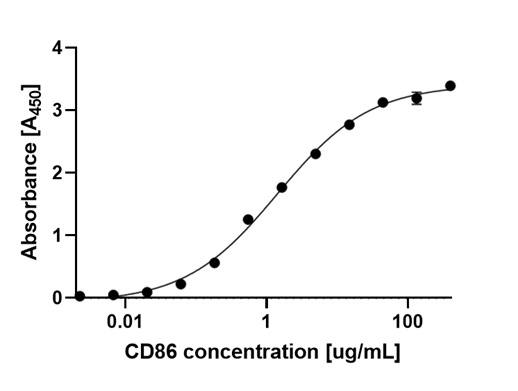| Alternative names | B7-2, B70 |
| Known ligands | CTLA-4, CD28 |
| Origin | Homo sapiens |
| Accession number | P42081 |




T-lymphocyte activation antigen CD86 (CD86; B7-2; B70) is type 1 transmembrane protein with an extracellular domain containing two Ig-like domains and shares ~25% sequence identity with CD80 (B7-1). (1) CD86, together with CD80 and B7-H2, serves as a ligand for CD28 and CTLA-4. (2) (3) Although CTLA-4 binding to ligands is stronger than CD28 binding, when in competition, CD86 has a relative preference for CD28 compared to CD80, which binds very strongly to CTLA-4. (4) Binding of CD86, CD80 or B7-H2 to CD28 delivers a positive signal to T cells, promotes proliferation and cytokine secretion and also results in up-regulation of IL-6 production by dendritic cells, causing immunostimulatory activity. (5) In contrast, the interaction of CTLA-4 with B7 ligands attenuates T cell activation and induces T cell anergy and additionally up-regulates IFN-γ resulting in tryptophan catabolism and suppression of T cell proliferation. (5) CD86 is constitutively expressed on the cell surface of the antigen-presenting cell (APC) and is rapidly up-regulated upon interaction with CD28 as opposite to the CD80 which is expressed inducibly. (5)
- Lenschow DJ et al. CD28/B7 system of T cell costimulation. Annual Review of Immunology. 1996, Vol. 14, pp. 233–258.
- Azuma M et al. B70 antigen is a second ligand for CTLA-4 and CD28. Nature. 1993, Vol. 366, pp. 76–79.
- Chen L and Flies DB. Molecular mechanisms of T cell co-stimulation and co-inhibition. Nature Reviews Immunology. 2013, Vol. 13, 4, pp. 227-242.
- Esensten JH et al. CD28 costimulation: from mechanism to therapy. Immunity. 2016, Vol. 44, 5, pp. 973–988.
- Bhatia S et al. Different cell surface oligomeric states of B7-1 and B7-2: Implications for signaling. PNAS. 2005, Vol. 102, 43, pp. 15569-15574.
